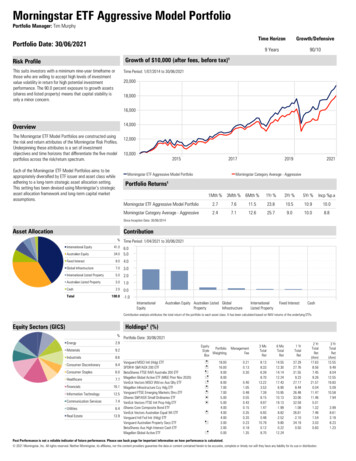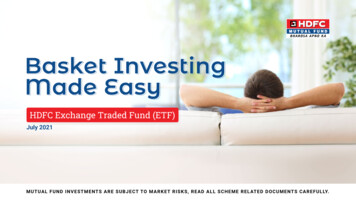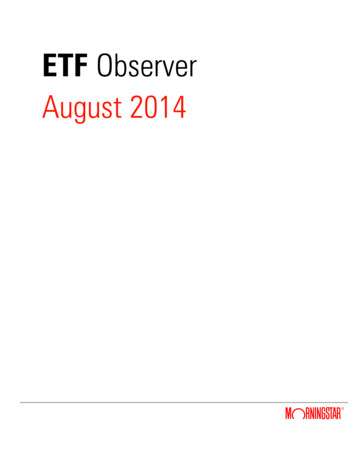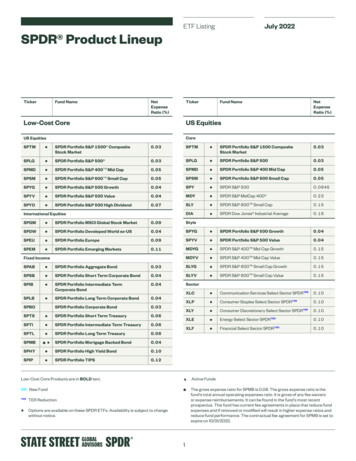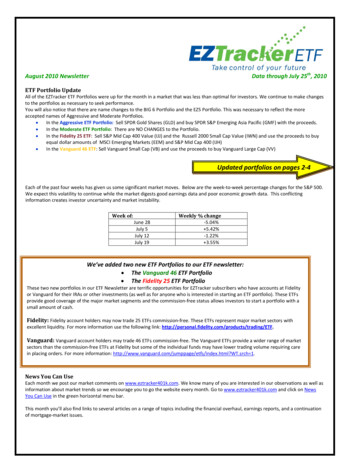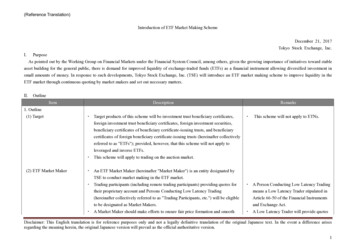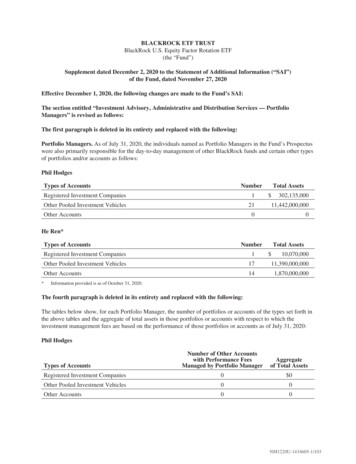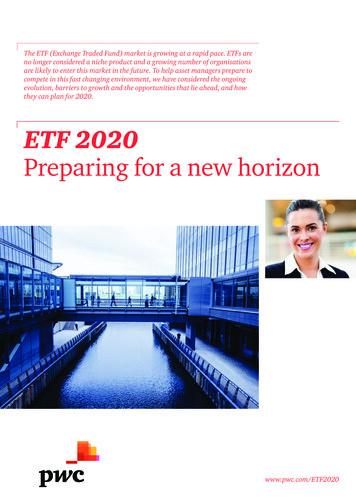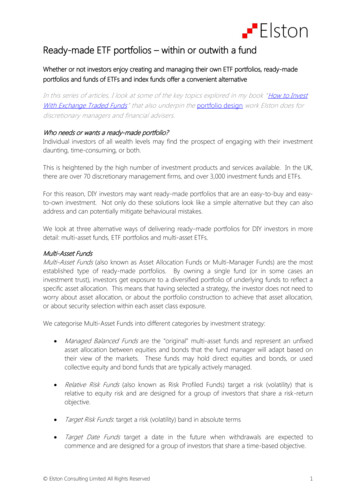
Transcription
Ready-made ETF portfolios – within or outwith a fundWhether or not investors enjoy creating and managing their own ETF portfolios, ready-madeportfolios and funds of ETFs and index funds offer a convenient alternativeIn this series of articles, I look at some of the key topics explored in my book “ How to InvestWith Exchange Traded Funds” that also underpin the portfolio design work Elston does fordiscretionary managers and financial advisers.Who needs or wants a ready-made portfolio?Individual investors of all wealth levels may find the prospect of engaging with their investmentdaunting, time-consuming, or both.This is heightened by the high number of investment products and services available. In the UK,there are over 70 discretionary management firms, and over 3,000 investment funds and ETFs.For this reason, DIY investors may want ready-made portfolios that are an easy-to-buy and easyto-own investment. Not only do these solutions look like a simple alternative but they can alsoaddress and can potentially mitigate behavioural mistakes.We look at three alternative ways of delivering ready-made portfolios for DIY investors in moredetail: multi-asset funds, ETF portfolios and multi-asset ETFs.Multi-Asset FundsMulti-Asset Funds (also known as Asset Allocation Funds or Multi-Manager Funds) are the mostestablished type of ready-made portfolios. By owning a single fund (or in some cases aninvestment trust), investors get exposure to a diversified portfolio of underlying funds to reflect aspecific asset allocation. This means that having selected a strategy, the investor does not need toworry about asset allocation, or about the portfolio construction to achieve that asset allocation,or about security selection within each asset class exposure.We categorise Multi-Asset Funds into different categories by investment strategy: Managed Balanced Funds are the “original” multi-asset funds and represent an unfixedasset allocation between equities and bonds that the fund manager will adapt based ontheir view of the markets. These funds may hold direct equities and bonds, or usedcollective equity and bond funds that are typically actively managed. Relative Risk Funds (also known as Risk Profiled Funds) target a risk (volatility) that isrelative to equity risk and are designed for a group of investors that share a risk-returnobjective. Target Risk Funds: target a risk (volatility) band in absolute terms Target Date Funds target a date in the future when withdrawals are expected tocommence and are designed for a group of investors that share a time-based objective. Elston Consulting Limited All Rights Reserved1
Target Absolute Return Funds target a return objective and are unconstrained in theirinvestment approach.Fig.1. Multi-Asset Fund types summarisedManaged BalancedAsset allocation approachDiscretionary assetallocationRelative Risk FundStatic or Dynamicallocation. Allocation torisk assets remainsrelatively constant overtime.Target Risk FundsTypically Dynamicallocation to target astable volatility band.Static or dynamicallocation. Assetallocation to risk assets isreduced on approach toand after the Target Datein the name of the fund.Dynamic allocationunconstrainedTarget Date FundsTarget Absolute ReturnFundsUnderlying holdingsDirect holdings, or activeor passive underlyingfunds.Underlying funds aretypically active funds,index funds or ETFsUnderlying funds aretypically index funds orETFsUnderlying funds aretypically index funds orETFsUnconstrained activeunderlying funds, passiveunderlying funds, directsecurities, derivatives,structured productsExampleJupiter Merlin IncomeFundArchitas Multi-AssetActive/Passive/BlendedHSBC Global StrategyFund rangeLGIM Multi-Index FundrangeVanguard LifeStrategyrangeBlackRock MyMap rangeVanguard TargetRetirement Fund rangeASI Global AbsoluteReturn Fund, BNY MellonReal Return FundSource: Elston, for illustration onlyDespite the cost of wrapping underlying funds within a fund structure, economies of scale meanthat Multi-Asset Funds can be delivered to investors at highly competitive price points with verylow minimums. However, the disadvantage is that Multi Asset Funds have a one-size-fits-allapproach that means there is little scope for customisation to the individual needs andcharacteristics of the investor’s objectives and constraints.ETF PortfoliosETF Portfolios are basket of individual ETFs providing an asset allocation. Rather than wrapping aninvestment strategy within a fund, a model portfolio is made available as a basket of ETFs that canbe bought individually to create the strategy. Model portfolios may be “strategic” (rebalanced tofixed weights of the same securities) or “tactical” (rebalanced to changing weights of the same ordifferent ETFs). Model portfolios are research portfolios meaning that the model portfolioprovider has no control of client assets so it is up to a portfolio manager, adviser or DIY investorto implement any changes should they wish to follow a given model portfolio strategy.The advantages of ETF Portfolios include: firstly, potentially lower fees owing to removal of a fundwrapper to hold the strategy; secondly greater flexibility and specificity with regards to assetallocation design; and lastly agility as strategies can be launched or closed with ease.An example of an ETF Portfolio could be as simple as a classic global 60/40 Equity/Bond strategy Elston Consulting Limited All Rights Reserved2
constructed with ETFs.Fig.2. Example of a simple ETF PortfolioWeight60%Index exposureFTSE All-World Index40%Bloomberg Barclays GlobalAggregate Bond IndexIndex tracking ETFVanguardFTSEAll-WorldUCITS ETFSPDR Bloomberg BarclaysGlobal Aggregate Bond UCITSETFTickerVWRLGLBLSource: Elston, for illustration onlyWhilst ostensibly very simple – a two security portfolio – the underlying holdings of each ETFmeans that investors get exposure to 3,133 equities in global and developed markets(approximately 47 countries) and 1,660 investment grade bonds in over 24 countries. Put simply,the investor is able to buy the bulk of the global equity and bond markets with two simple trades.When manager, advisers or research firms create model portfolios, the weighting scheme can beone of three types as summarised in the table below.Fig.3. Types of ETF Portfolio Weighting schemeTypeStrategic-StaticAsset allocation approachStatic allocation (rebalanceto original weights onrebalancing dates).Strategic-DynamicDynamic allocation onrebalancing dates.Tactical-DynamicDynamic allocation onrebalancing dates.Source: Elston, for illustration onlyUnderlying holdingsSame basket of ETFs.Same basket of ETFs.Changing basket of ETFs.The ability to design and create ETF Portfolios with an increasing number of ETF building blocksmeans that both traditional (asset managers, stock brokers) and non-traditional providers (e.g.trade publications, investment clubs, industry experts) can create investment strategies that can be“followed” by investors. However, the usual due diligence rules for any investment providershould be applied as regards their investment process.Whilst the rise of more bespoke ETF strategies is welcome, the convenience of having a singlestrategy delivered as a single security from a portfolio construction perspective is attractive. This iswhere Multi-Asset ETFs could have a role to play.Multi-Asset ETFsMulti-Asset ETFs are an emerging way of delivering the returns of a managed ETF Portfolio usinga single instrument. Whereas multi-asset funds are often funds of index-tracking funds, MultiAsset ETFs can be viewed as an “ETF of ETFs”.In the US, there are a number of multi-asset ETFs available providing a ready-made allocationwithin a single trade. In the UK, there are currently only two ranges of multi-asset ETFs available. Elston Consulting Limited All Rights Reserved3
Multi-Asset Infrastructure (launched April 2015)SPDR Morningstar Multi-Asset Global Infrastructure UCITS ETFESG Multi-Asset ETFs (launched September 2020)BlackRock ESG Multi-Asset Conservative Portfolio UCITS ETF (MACG)BlackRock ESG Multi-Asset Moderate Portfolio UCITS ETF (MAMG)BlackRock ESG Multi-Asset Growth Portfolio UCITS ETF (MAGG)We expect multi-asset funds, constructed with ETFs and index funds, to gain more traction thanmulti-asset ETFs because as a “buy and hold” ready-made portfolio multi-asset funds do not needthe intraday dealing availability that ETFs provide.Multi-asset funds (constructed with index funds/ETFs), ETF Portfolios, and Multi-asset ETFs providea ready-made one stop for delivering a multi-asset investment strategy for all or part of aninvestment portfolio, whether defined by a multi-asset index or not.The advantages of a multi-asset fund of ETFs as a ready-made portfolioThe advantages of a “one and done” approach include collectivisation, convenience andconsistency.Firstly, is collectivisation of investor’s by objective which creates cost efficiency from the economiesof scale. Adopting a collectivised approach, can be done where each group of clients shares thesame goal (as defined by, for example, a target risk level or income objective, or volatility objectiveor target date). This can help achieve economies of scale and lower the cost of offeringprofessionally managed asset allocations in at least three different ways. Firstly, each cohortbecomes a multi-million pound ‘client’ of an asset manager who can deploy institutional-typebargaining power on the pricing of the underlying funds within their asset allocation. Secondly,the collective scale reduces frictional trading costs of implementing the asset allocation decisions:one managed investment journey is more efficient to manage and deliver than thousands ofindividual ones. Finally, by focusing on actively managing the asset allocation as the maindeterminant of the level and variability of returns1 the asset allocation can be implemented withindex-tracking ETFs to keep costs down.Secondly is convenience. Rather than focusing solely on building optimal multi-asset classportfolios that need monitoring, the proposition of investment offerings can be engineered toeliminate poor behavioural tendencies that prevent effective management. Engineering funds sothat they offer a single investment journey which investors do not necessarily need to monitorregularly in order to reach their goals can help reduce the perceived hassle of investing. This canmotivate individuals to invest. Such professionally managed funds prevent investors from eithernot rebalancing the portfolio or doing it in an improper fashion due to behavioural tendenciessuch as status quo bias2 and disposition effect3. Furthermore, a professionally managed strategycan respond to other risks aside from market risk such as shortfall, concentration or longevity riskswhich lay investors can overlook. An additional advantage of offering managed diversified funds isthat it automatically curtails the number of products offered, thereby reducing cognitive load ofIbbotson, “The Importance of Asset Allocation.”Samuelson and Zeckhauser, “Status Quo Bias in Decision Making.”3Shefrin and Statman, “The Disposition to Sell Winners Too Early and Ride Losers Too Long”; Weber and Camerer, “The DispositionEffect in Securities Trading.”12 Elston Consulting Limited All Rights Reserved4
making an investment decision and can prevent decision deferral.4Finally is consistency. Investors in each strategy experience the same time-weighted investmentreturns thereby reducing the likely dispersion of returns that a group of investors wouldexperience through an entirely self-directed approach. This consistency is why multi-asset fundshave also been adopted by some financial advisers as a core or complete holding within acentralised investment proposition.The disadvantage of a ready-made portfolio are not secret. They are designed as a “one-size-fitsall” product with no scope for customisation.The respective features of the various types of ready-made portfolio are set out below. Whereasmulti-asset funds of ETFs, and multi-asset ETFs can be accessed via a single trade, their scope forcustomisation is low. ETF Portfolios have the highest degree of flexibility for creating customstrategies, but are not accessible via a single trade.Fig.4. Comparing ready-made portfoliosFlexibilityMulti-Asset Fund of ETFsLowETF PortfolioHighMulti-Asset ETFLowSource: Elston, for illustration only.Single Trade Exchangetraded SummaryReady-made portfolios are easy to buy and easy to own. They enable a “set and forget”approach to investment management which can help design out key behavioural risks, or providea useful core holding to a broader strategy.Obviously the primary choice is which strategy an investor must choose, or their adviser shouldrecommend depending on their risk-return objectives and suitability considerations.4Iyengar and Jiang, “How More Choices Are Demotivating”; Iyengar, Huberman, and Jiang, “How Much Choice Is Too Much?” Elston Consulting Limited All Rights Reserved5
ETF Portfolios ETF Portfolios are basket of individual ETFs providing an asset allocation. Rather than wrapping an investment strategy within a fund, a model portfolio is made available as a basket of ETFs that can be bought individually to create the strategy. Model portfolios may be "strategic" (rebalanced to
